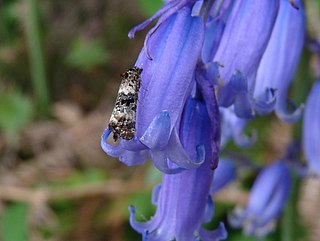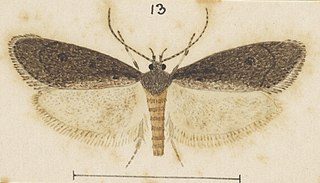
Hypena proboscidalis, the snout, is a moth of the family Erebidae. The species was first described by Carl Linnaeus in his 1758 10th edition of Systema Naturae.

Izatha apodoxa is a moth of the family Oecophoridae. It is endemic to New Zealand, where it is known from scattered localities in the southern North Island. This species is variable in appearance and comes in two forms, a grey form and a black and white form. In the grey form it is very similar in appearance to I. notodoxa and in the black and white form to I. katadiktya. At present the larvae and biology of this species is unknown.

Izatha prasophyta is a moth of the family Oecophoridae. It is endemic to New Zealand, where it is known from the North Island, except Hawkes Bay or the Wairarapa. Larvae likely feed on rotting wood although larvae of this species have been reared on the fruiting body of the bracket fungus Bjerkandera adusta. Adults are on the wing from November to February.

Hysterophora maculosana, the bluebell conch, is a species of moth of the family Tortricidae. It is found from most of Europe, east to the Crimea, Asia Minor and the Palestinian territories. The habitat consists of woodland areas.
Filatima xanthuris is a moth of the family Gelechiidae. It is found in North America, where it has been recorded from North Carolina, South Carolina, Texas, New Mexico, Arizona, Utah, Nevada, Manitoba, Alberta, British Columbia, Washington and Oregon.
Antaeotricha sterrhomitra is a moth of the family Depressariidae. It is found in Brazil (Amazonas).
Antaeotricha dromica is a species of moth of the family Depressariidae. It is found in Brazil (Para).
Anadasmus byrsinitis is a moth of the family Depressariidae. It is found in Colombia.
Antaeotricha ptycta is a species of moth of the family Depressariidae. It is found in Guatemala, Panama, Ecuador, the West Indies and Guyana.
Stenoma gymnastis is a moth of the family Depressariidae. It is found in Guyana, French Guiana and Brazil.
Stenoma epicnesta is a moth of the family Depressariidae. It is found in Guyana.
Stenoma hemilampra is a moth of the family Depressariidae. It is found in French Guiana.
Falculina lepidota is a moth of the family Depressariidae. It is found in French Guiana.
Antaeotricha phollicodes is a moth of the family Depressariidae. It is found in French Guiana.

Tingena crotala is a species of moth in the family Oecophoridae. It is endemic to New Zealand and is found both in the North and South Islands. This species inhabits native forest and is on the wing in November and December.

Tingena hemimochla is a species of moth in the family Oecophoridae. It is endemic to New Zealand and has been observed in the North Island. Adults of this species are on the wing from December until March.

Tingena letharga is a species of moth in the family Oecophoridae. It is endemic to New Zealand and has been observed in Otago. Adults are on the wing in December and January.

Asaphodes nephelias is a moth in the family Geometridae. It is endemic to New Zealand and has been observed in the South Island. The preferred habitat of this species is alpine tussock grasslands above native forest and in wetlands. The adults of this species are on the wing from January to March and are day flying. The female has brachypterous wings.

Atomotricha ommatias is a moth in the family Oecophoridae first described by Edward Meyrick in 1883. It is endemic to New Zealand and has been observed in the South Island. This species inhabits shrubland. The adults are out in the spring months of August and September and are attracted to sugar traps. The female of the species os brachypterous and is incapable of flight. Both the male and female of the species have been observed resting on fences during cold nights. The female, if touched, will hop two or three inches.

Trachypepla protochlora is a moth of the family Oecophoridae first described by Edward Meyrick in 1883. It is endemic to New Zealand and is found in both the North and South Islands. The preferred habitat of this species is native forest and adults are on the wing from October until February. Adults can be variable in their green shaded colour as well as in the intensity of markings on their forewings. The greenish ground colouration of this moth ensures they are well camouflaged when at rest on green mosses and lichens.









